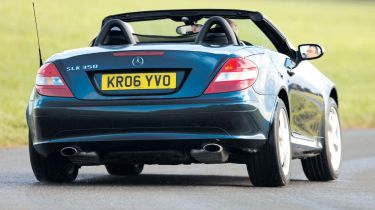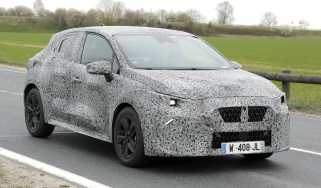Mercedes SLK 350
Does the Merc’s folding hard-top give the SLK an extra advantage?
Fresh from a thorough revamp, the Mercedes SLK outsold the TT Roadster in the UK last year. However, that’s hardly surprising, given the fact the
first-generation Audi was six years old. But what we want to find out now is if the SLK deserves to keep its lead in 2007.
Let’s start with the styling. Unlike the Audi, the Mercedes has a traditional roadster shape, with a long nose and a short tail. But although it doesn’t have the same great detailing when viewed up close, the F1-inspired pointed front, sculpted flanks and short tail give it an athletic appearance. And until you see it in action, it’s hard to believe that the roof actually fits under the bootlid – that’s one reason why this work of engineering art is something that owners will never tire of watching.
It’s a shame that it cannot be lowered while cruising gently along for ultimate poseur appeal, but as with the Audi TT’s top there are no catches to release. And the mechanism works quietly, if not exactly quickly. But this isn’t a roof to be rushed – as we said, the way the metal moves is pure poetry in motion.
Even with the top down there’s 208 litres of space in the boot, and with it up the bigger glass area it offers over rivals – it has a larger back screen and taller side windows – not only boosts visibility, but means the cabin is bright and airy.
Used - available now

2019 Ford
EcoSport
26,265 milesManualPetrol1.0L
Cash £10,000
2019 Ford
Kuga
38,284 milesManualDiesel1.5L
Cash £13,700
2020 Mercedes
E-Class
38,351 milesAutomaticDiesel2.0L
Cash £21,500
2019 BMW
X1
46,228 milesAutomaticDiesel2.0L
Cash £14,500Unfortunately, the extra light focuses attention on the Merc’s cabin materials, and after the TT and Boxster, the SLK’s shinier, harder
plastics and cheaper looking trim aren’t very appealing. That’s a shame, since the Mercedes is otherwise very elegantly laid out. However, from the springy pedals to the wobbly column stalks and light steering, none of the controls operate with the precision that Porsche and Audi drivers will be used to.
The vague responses mean the manual SLK isn’t the easiest car to drive at low speeds – and that’s not good when you’ve got 272bhp under your right foot. It can kangaroo when pulling away, due to the long-travel clutch and notchy, awkward gearchange. Mercedes’ seven-speed automatic undoubtedly works better with the 3.5-litre V6 than the manual, but whichever you go for, one thing is guaranteed – Porsche-beating acceleration. With a flat torque curve from 2,400rpm to 5,000rpm and a surprisingly light 1,465kg kerbweight, the rear-wheel-drive SLK scorched from 30-70mph in 5.1 seconds, seven-tenths ahead of the Audi. But while overtaking is effortless and the motor is flexible, it doesn’t sound particularly great. Compared to the meaty TT and 350Z, the SLK’s engine note is rather muted and is accompanied by a distinct transmission whine at higher revs.
The brakes aren’t that impressive, either. It took longer to come to a halt from 60mph than any rival, the ABS activates too quickly and the pedal lacks feel. The same applies to the over-assisted steering, while the suspension isn’t as controlled as rivals, with a tendency to pitch and dive when pushed. This makes it feel comparatively loose and sloppy, a sensation not helped by the over-active traction control. Driven in isolation, the SLK is rewarding, but it’s not a genuine sports car.
Instead it’s happiest when cruising. Although it bucks a bit on bumpy B-roads, generally it’s supple and relaxing. Combine that with the sense of security and isolation generated by the hard-top, and the Mercedes is the best car here for long trips. However, while we can appreciate that the roof must have cost millions to develop, the SLK still seems expensive compared to the TT.
Details
Price: £35,430
Model tested: Mercedes SLK 350
Chart position: 4
WHY: The SLK is a purpose-built roadster and is unique in this test as it has a folding metal roof.
Economy
As with the Nissan, long gearing aided the SLK. It achieved an identical 22.4mpg to the 350Z, although cruising on the motorway saw this rise to 27mpg.
Residuals
The SLK fares really well on the used market, holding on to 57.7 per cent of its new cost. It’ll lose the same amount of money as the £5,000 cheaper 350Z.
Servicing
Mercedes’ network doesn’t enjoy the best reputation, while a £600 third service takes the cost of the first three visits to £1,063, second only to the Boxster.
Tax
It’s not good news if you want an SLK 350 as a company car. As it has the highest list price, top band taxpayers will shell out nearly £5,000 per year.







